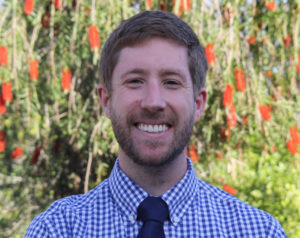 With a nurse for a mom and a veterinarian for a dad, Kevin Schneider was primed to go into science. In particular, he wanted to be a doctor. But at UC San Diego (UCSD), while doing research and shadowing physicians, he realized he was enjoying lab work much more than working in the hospital. So he decided to pursue research instead.
With a nurse for a mom and a veterinarian for a dad, Kevin Schneider was primed to go into science. In particular, he wanted to be a doctor. But at UC San Diego (UCSD), while doing research and shadowing physicians, he realized he was enjoying lab work much more than working in the hospital. So he decided to pursue research instead.
Schneider’s introduction into real academic research came studying circadian rhythms in fungi. Upon graduating from UCSD in 2005, he says, “I became the lab manager, and I continued my work looking at the genes and molecular pathways associated with regulating circadian rhythms, as well as those compounds that induced or protected against oxidative stress, which led to some of my future research.”
He started graduate school at UC Irvine (UCI) with an interest in something “more biologically relevant to diseases” and wound up in a lab that studied several genes that help protect against oxidative stress. He focused his research on an animal model that was more susceptible to oxidative stress damage. While working in this lab, Schneider says, he had two major discoveries: “First, I met my fiancée, who was the lab manager. Second, we published a paper based on the mouse lines we were working with. … One of the surprising things we found was that while these animals had increased levels of oxidative stress, they were highly resistant to diet-induced obesity. These animals remained lean, even on a high-fat diet, and it turned out it was a result of, essentially, supercharged mitochondria.”
Looking for other labs with more mitochondrial experience, the researchers began collaborating with the Discovery Eye Foundation’s (DEF) director of research, Dr. Cristina Kenney in UCI’s Department of Ophthalmology, who helped them publish their major paper on mitochondrial function.
“As I finished my graduate career, Dr. Kenney offered me a fantastic opportunity to do my post-doc work in her lab, and I jumped on it,” Schneider says. He became the second Arnold and Mabel Beckman Fellow at the Gavin Herbert Eye Institute at UCI. Funded by the Beckman Foundation and DEF, Schneider now studies the role of mitochondria in the development and progression of age-related macular degeneration (AMD).
“This lab has a unique system that is very clinically relevant, because we generate retinal cell lines using the mitochondria of patients,” he says. “We have found there is something systemically and critically different about the mitochondria of people with AMD that seems to predispose them to the development of AMD. … We found that how each cell line reacts is mirrored by how the patient reacts. One of the most common treatments for wet AMD is intraocular injections, and we see that in many ways these cell lines respond to them in the same way the patients do.” These cell lines may be usable to screen for the potential success of drug treatments for AMD.
Also relevant to Schneider is the contact he has with those who fund his research through DEF. “When we interact with our donors — presenting findings, talking about our progress — I realize our work is more than just science for science’s sake,” Schneider says. “It helps drive the work we do — to have that human connection.”

